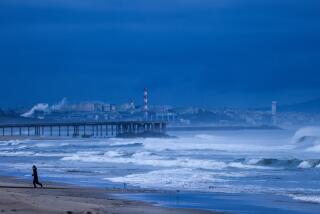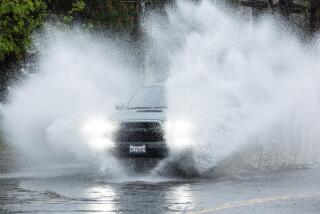Storm now has its eye on the Southland
A strong winter storm barreled through the state Friday, delivering heavy rain and hurricane-force winds in Northern California before descending on the Southland for what forecasters predicted would be a wet and dangerous weekend.
Scattered showers throughout Friday turned into sustained rain by the evening, prompting mandatory evacuations for 4,000 residents in several Orange County canyons and triggering flash-flood warnings for nearly all of Los Angeles County, all of Ventura County and much of the Inland Empire.
Forecasters say they expect between 2 and 4 inches of rain along the coasts and in the valleys of L.A. and between 4 and 8 inches in the mountains. Some isolated mountain areas could see 10 inches. About a foot of snow could settle at elevations of more than 7,000 feet.
The biggest problems so far have occurred to the north, where 40 miles of power lines and 105 poles were damaged, leaving 1.3 million households without electricity since Friday morning.
Officials closed several major routes, including the 101 Freeway in Marin County, the Richmond-San Rafael Bridge and a 76-mile portion of Interstate 80 in the Sierra -- a key east-west route that was experiencing blizzard-like conditions and snow of up to 5 feet.
Trucks were barred from traveling on the Golden Gate Bridge after wind speeds there reached 70 mph. Gusts of 67 mph were recorded at San Francisco International Airport, while gusts of 165 mph scoured the highest elevations of the Sierra.
“It’s really howling,” said Kelly Redmond of the Western Regional Climate Center at the Desert Research Institute in Reno.
By 4 p.m. Friday, 2 inches of rain had fallen on San Francisco, 3.8 inches in Santa Cruz and 6.1 inches at Big Sur, about 30 miles south of Monterey.
The combination of rain and winds made for a scary commute, especially for motorists navigating extreme winds on Bay Area bridges.
“You had to go really slow, otherwise you’d get thrown into the other lane,” said Dan Miyake, a Starbucks manager who drove 10 mph over the Golden Gate Bridge on Friday. “It was really high winds. The rain was pouring. . . . In the streets of San Francisco, the puddles were easily to the bottom of your car door.”
Ferries connecting San Francisco to the East Bay and Marin County were canceled in the morning because of rough waters. In Marin County, so many roads were flooded or blocked by flying debris that the Golden Gate Transportation District suspended bus service for several hours. Downed trees caused delays on the BART rail system and on San Francisco’s Muni streetcar lines.
Crews battled to keep open California 17, the main road connecting Santa Cruz to the Bay Area, which experienced a landslide and downed power lines.
In Southern California, where many hillsides were left denuded by wildfires in October, Gov. Arnold Schwarzenegger directed emergency workers to prepare for heavy rain, snow, wind and flooding.
The National Weather Service issued flood warnings for southeastern Santa Barbara County in addition to much of Southern California.
As of 8:30 p.m., the Los Angeles Department of Water and Power reported that 6,000 of its 1.4 million customers were without power across the city. Southern California Edison reported that as many as 13,000 customers lost power throughout the region. Power was restored to all but 2,100 customers by 10 p.m.
State lottery officials in Sacramento said the storm damaged computer operations there, preventing them from publicizing the day’s winning numbers and possibly creating problems through the beginning of next week.
The downpour caused 90-minute flight delays at Los Angeles International Airport, according to a spokesperson, and travelers were advised to check with their airlines to determine if their flights are delayed.
By 11 p.m. Friday, Los Angeles fire crews closed Forest Lawn Drive in Toluca Lake because of flooding and possible mudslides. The damage prompted a voluntary evacuation of the Oakwood apartment complex, authorities said. In Malibu, mud and rock slides cut off a section of Corral Canyon Road.
The storm had stalled in the Pacific before moving into the region. The rains were expected to peak this morning and give way to lingering precipitation through tonight, when another storm was predicted to hit. Weaker than the first system, this storm is expected to persist until Sunday.
Philip Gonsalves, a forecaster with the National Weather Service in San Diego, said the storm will hit Southern California hard but probably not with as much force as it did in Northern California.
By early evening Friday, authorities had issued a mandatory evacuation order for residents of the Modjeska, Silverado, Williams and Harding canyon areas of Orange County, after residents there had spent much of the day brooding over forecasts of heavy rain. The canyons are at substantial risk for mudslides.
“My stomach is in knots. It’s so scary,” said Modjeska Canyon resident Pam Erickson, who operates a horse ranch with her husband.
“I used to enjoy the rain. Now it scares me. We’ve been through the fires; now this.”
Despite the potential for significant damage, experts said the soaking was long overdue.
Not only has the region been exceedingly dry for nearly three years, but every other major source of water has also experienced drought, including the Sierra and the Colorado River Basin.
As a result, water rates are expected to increase, and communities across Southern California are initiating conservation efforts and discussing the possibility of water rationing.
Water managers and climatologists say it would take a series of major storms for the region to begin to make any dent in the prolonged drought.
Bill Patzert, a climatologist with the Jet Propulsion Laboratory in La Canada Flintridge, said he hoped the storm lives up to its billing, because previous downpours had not. What the region really needed, he said, was considerably more than just a pretty good soaking.
“We need six years of El Nino in a row,” Patzert said. “Even though it’s raining right now, this is not even a drop in the bucket for the drought.”
--
paloma.esquivel@latimes.com
hector.becerra@latimes.com
Times staff writers David Reyes and Tony Perry contributed to this report.
More to Read
Sign up for Essential California
The most important California stories and recommendations in your inbox every morning.
You may occasionally receive promotional content from the Los Angeles Times.













